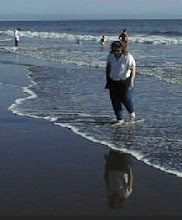
As you can see, there is no next bead to go through! So we need to do a little fancy footwork in order to finish the row and begin the next one. First, when you reach the end of the row, continue through both of the last two beads of the base row. Then pick up the last bead of the new row and go left through the second and third beads from the end in the base row.

Then go up and to the right through the bead above the bead your thread is coming out of and down and to the right through the second to last and last beads of the base row once again. Then go up and left though the bead you added. Your thread should now be in position to begin the next row. You will need to use this technique every other row.



Now you will need to close up the bottom. Squeeze the cylinder flat with the flower centered in the front. There should be one bead on each side that kind of sticks out between the two layers. Your thread should be coming out of one of these beads. Weave your way over there if necessary. Pick up a bead and go under the threads that go from the end bead to the beads on each side.

Then go back up through the bead you just added. Continue across the bottom 'till you get to the end.
Then add one piece of fringe for each bead you just added. Start with 5 blue beads and one daisy for the first one, then increase the number of blue beads by 5 each time until you reach the center, then decrease by 5. The daisies are pink with white centers. If you do not know how to make daisies, here's where you can learn the basic Daisy Chain stitch, omitting the dagger bead, unless you want a leafy fringe! After you make a daisy, go back around the daisy to the top and up through the blue beads and the bead your thread is coming out of. Then go down through the next bottom edge bead and repeat the process. The top edge of the bag sports triangle trim. To make it, weave up to the top of the bag and pick up 3 blue beads. Go down through the next bead at the top of the bag and then up through the following one. Repeat around the edge of the bag.

The strap consists of 5 blue beads, 1 pink, 1 white (I used slightly larger ones), 1 pink, 5 blue, 1 green, 1 daisy, 1 green and then repeat until you reach the length you want. I think it looks best as a short necklace with the bag hanging near the breastbone. Have fun with this cool variation of Peyote Stitch!
This content created by Emily Hackbarth




